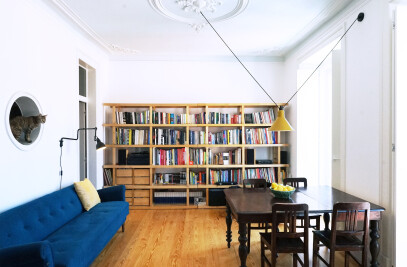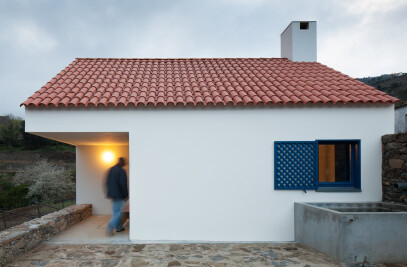This is the refurbishment and enlargement of a house in the Barrocal region of the Algarve, in the south of Portugal. This is a transition area between the coast and the Caldeirão Range of Hills to the north, mostly agricultural land producing citrus fruits, almonds and figs.
The main house, built a hundred years ago, borders the main road to the south, and separates the relatively short front from the extensive agricultural land to the back.
The client, born in this house, intended to divide her time between an urban life in Lisbon and the Algarve, accommodating at times a large extended family.


The house follows a recurring typology in southern Portugal consisting of a long shallow-steeped gable roof volume that can be extended at will, and has a basic, strict, repetitive modulation that sets windows/doors and interior compartments at regular intervals. Typically, these compartments don´t have a specific use, except for the room with the chimney which indicates the position of the kitchen. The axial symmetry of the façade, accentuates the central entrance door, reinforced by a corridor that crosses to the back, where the façade is repeated, except for minor details in the decoration of the stonework, which is simplified. Around this main volume, other smaller, informal volumes were added, mainly for storage and with varying roof configurations. These volumes, bordering a narrow side street, create a small patio together with the main house, and reinforce the southern tradition of positioning buildings along the limits of the public accesses to provide seclusion and freedom in the interior. The continuation of the main street façade, punctured by a door, uniting both sets of volumes in a single wall, is further proof of this intention.


Our intervention sought to clarify the internal organization, to its most basic original form, removing interior partitions and other subsequent interventions, and introducing new elements which strive for simplicity, but radically alter its use:
The main interior corridor was maintained, complemented by a longitudinal access to the new bathrooms, and a new access to the upper floor, which originally was used only for storage and only accessible from the outside. The main room, which possessed a chimney, was altered into a double-height room, and a small high window was introduced, connecting both floors visually, at the end of the promenade through the house.


New openings were made in the structural longitudinal interior supporting wall, connecting living room to kitchen, and providing a circular path inside this social area. A new side opening in the kitchen and complementing protection slab unites the main volume with the other volume and provides a direct entrance to the kitchen. The upper floor was divided into small bedrooms along a corridor that ends in a taller lounge space, under a single gable dormer that extends from the front to the rear façade.
On the outside, shaded areas were introduced under the large pergolas, both for the new car port and the full extension of the north façade, bordering a new swimming pool. Materials were restricted to the traditional terracotta tiles on the floor throughout the house and pool area, terracotta roof tiles, white stuccoed walls, pine wood planks over the light construction of the upper floor, light blue painted carpentries on the inside and a darker hue on the outside.


This region shares with other Mediterranean countries a passion for white washed volumes of elementary geometrical clarity, admired by Le Corbusier, revealed to full advantage by the play of light and shadows. Our intervention draws on this tradition, continuing the language of the existing circular well and cubic water deposit, both in the white purity of the dorm windows as in the cylinder and sphere of the new staircase. This staircase also reinterprets the Moorish influence in this region, especially with the introduction of small solid glass oculi inserted in the cupola in a geometric pattern, with varying light effects throughout the day.


Team:
Architect: SAMF Arquitectos
Lead Architects: Sara Antunes, Mário Ferreira
Collaborators: João Paulo Encarnação
Construction: Nuno Brito Engenharia Civil
Structural Consultant: Engº José Marques
Decoration: Rita Monjardino
Landscape Design: Manuel Pacheco, Rosa Ávila Pacheco
Photography: Hugo Santos Silva


Material Used:
1. Facade cladding: Rendered Plaster
2. Flooring: Terracota Tiles - Terracota do ALgarve
3. Doors: Exterior Woodwork - Carpintaria Maciça
4. Windows: Deleme Caixilhos
5. Roofing: Terracota Roof Tiles - Handmade

























































